Contact us
Live Chat with Tek representatives. Available 6:00 AM - 4:30 PM
Call us at
Available 6:00 AM – 5:00 PM (PST) Business Days
Download
Download Manuals, Datasheets, Software and more:
Feedback
MIPI M-PHY Transmitter Test Solutions
TekExpress M-PHY Tx with MPHY50 and MPHY40 Automated
More Information
- Máy hiện sóng lân quang số/tín hiệu hỗn hợp MSO/DPO70000DX
- Máy hiện sóng hiệu suất DPO70000SX ATI
- Explore more Software models
Read Online:

The Tektronix TekExpress M-PHY TX Automated test software for MPHY40 and MPHY50 product runs on Tektronix real-time oscilloscopes that are based on Windows 10 computer operating system. MPHY50 and MPHY40 Automated solution provide support for 100% of tests as per Spec 5.0 and CTS 1.0 at revision 02 using TekExpress 5.0 framework. It's state-of-the-art tool designed for automation. This solution is designed for engineers doing verification and validation as per the CTS for High Speed (HS)-Gear1, Gear2, Gear3, Gear4, and Gear5 for MPHY50 and HS-Gear1, Gear2, Gear3, and Gear4 for MPHY40. It also supports UFS4.0 Reference Clock measurements for both MPHY50 and MPHY40 products.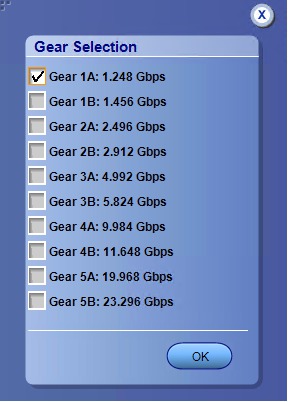
Key Features for M-PHY Transmitter testing
- 100% test coverage for all modes and data rates for HS–Gear1, Gear2, Gear3, Gear4, and Gear5 for MPHY50 and HS–Gear1, Gear2, Gear3, and Gear4 for MPHY40 products
The Application covers PWM and SYS modes. Supports UFS4.0 Reference Clock measurements for both MPHY50 and MPHY40 products
- M-PHY TX Automated User-defined mode allows modifying every parameter of different HS, UFS4.0 Reference Clock, PWM, and SYS tests for comprehensive debug analysis and characterization
- Automated testing reduces the complexity of executing transmitter tests and enables you to test devices faster
- Improved HS measurement execution performance
- Selection of different Gears and Subgears of HS, PWM, and SYS signals, large/small amplitudes, impedance terminated/Non terminated
Full Contour Extrapolated eye diagram for BER analysis in steps at E-6 to E-12
- HS Gear1 Mask Dynamic Movement to provide optimum eye opening as per specification
- Accumulation of 3 M UIs in a single acquisition reducing test times for analysis
- Ability to embed/de-embed using filter files to enable mid bus probing
- Support for tri mode probes for single-ended and differential signaling probing using Industry lowest noise probe P76xx series
- Manual mode testing for multiple lanes
- Highly optimized setup performs Power Spectral Density (PSD) tests using oscilloscope-integrated algorithms uniquely, and does not require an external spectral analyzer or extra hardware to perform PSD measurements
- Single printable report for all tests across different combinations, provides pass/fail summary table, along with margin details, optional waveform captures, and eye diagrams. Available in (.mht and pdf)
Applications
The Physical layer is implemented for various high-speed serial interfaces (chip to chip communication) inside mobile devices. The common interfaces which utilize the M-PHY solution are:
- RFIC and modem interfaces in mobile devices
Companion chip interface with application processor over Unipro/SSIC
- Storage over UniPro/UFS
M-PHY transmitter testing with TekExpress M-PHY TX
Single-button automated M-PHY transmitter testing
Once the test bench is set up and the DUT is properly connected, simply press the Run button to perform the selected test suite.

Automated transmitter testing saves time and resources
You do not need to be an expert on testing procedures. Remembering the exact steps to take each measurement is time consuming and often requires going back to the M-PHY specifications. M-PHY TX takes the guesswork out of conducting M-PHY Transmitter testing.
Even if you remember how to use the test equipment, it is common for even the most experienced operators to forget steps in the procedure or to set up the correct parameters, such as applying the correct signal impairments for a given test. M-PHY TX allows engineers to simply select the desired tests to run, and then work on other tasks while the tests are being executed.
Simple setup, test execution, and reporting
Test setup and test execution is very simple with the M-PHY TX Automated software. The test setup connections are very minimal, as it involves only one-piece of equipment for M-PHY TX. The TekExpress software provides a Graphical User Interface (GUI) and an intuitive workflow through setup and testing.
Setting up the bench
When setting up a test, nothing can be simpler than hooking up the test system by looking at a schematic. View the schematic of the selected test with a click of a button.
Pass/fail report
The M-PHY TX Report tab provides a single printable report of all the tests along with a Pass/Fail summary table, margins, and optionally waveform screen captures, eye diagrams, histograms, bathtub charts, etc.

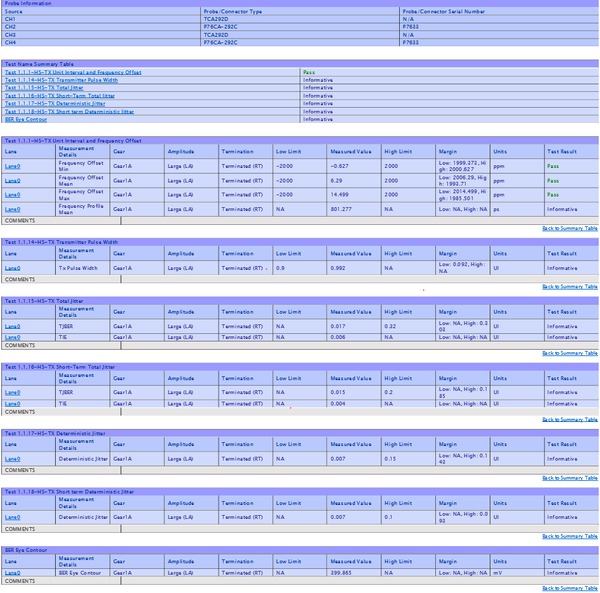
Transmitter Eye Diagram measurement
For M-PHY eye diagram, prorated parameter values are for a BER of 1E-12.
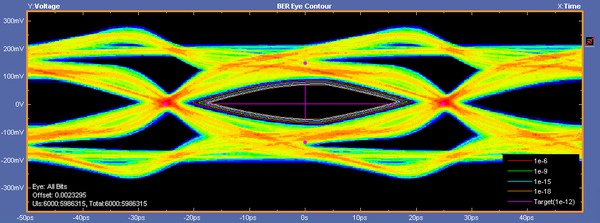
For HS G4 and G5, the eye diagram shows the accumulated eye at BER E-6 and extrapolated eye at various values in contour format. The extrapolated eye is at BER of 1E-12. Tektronix provides the unique ability for extrapolation using contours. This provide designers the level of confidence in their design, a good perspective on margin for their designs, and allows them to accomplish this task in less time without having to accumulate the eye at BER-12. 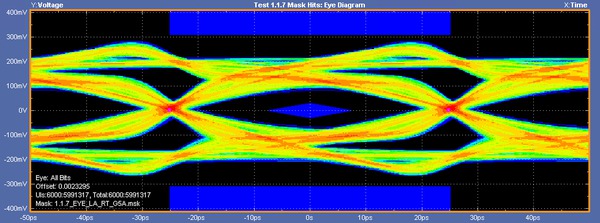
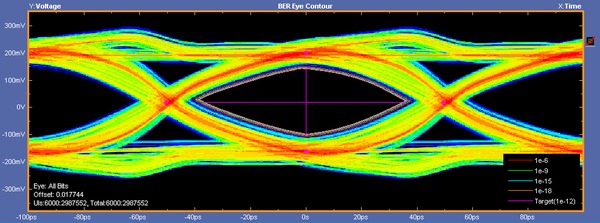
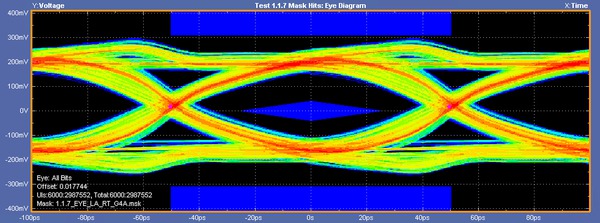
Embed/De-embedding for Mid-bus probing
For M-PHY TX testing, measurements are specified at the TX pins. Many a times, the users measure signals at the end of the channel to view the effect at the RX pins or some test point in the middle of the channel (Mid-bus probing). For conformance testing, to ensure that the values meet the CTS, there would have a need to embed and/or de-embed channel to make measurements at the pin.
TekExpress Automated software allows you to do mid-bus probing via embedding/de-embedding signal path using filter files. You can use the 'Filter Setup' option in DUT panel to add the filters. This setting is applied globally to all the measurements during acquisition. 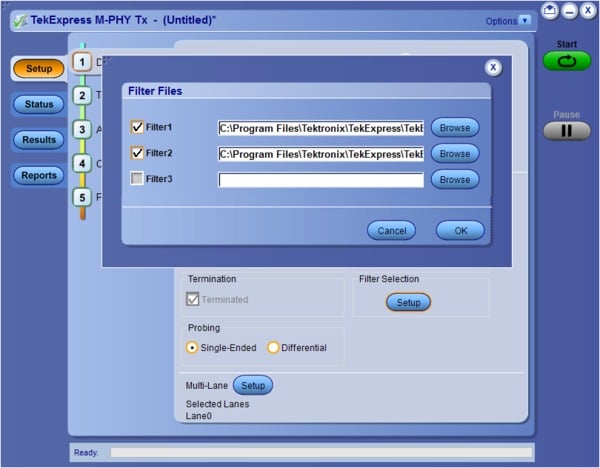
Probing needs for M-PHY
The requirements for measurement equipment used to test conformance of an M-PHY transmitter running in High Speed mode is summarized below.
| Requirement | Performance |
|---|---|
| Return Loss | Per specification limits |
| Differential termination | 100 Ω across input |
| Common mode termination | Infinite or consistent value |
| Rise Time | 3X fastest signal rise time |
| Sensitivity | 200-300 mVFS capability |
| Noise | Minimal added noise, (<1 or 2 mVrms desirable) |
| Attenuation | Smallest attenuation possible (1X desirable) |
The MIPI M-PHY standard presents significant challenges for oscilloscopes and probing. These challenges result in stringent requirements for HS-MODE measurements. SMA style probes with 50 Ω inputs have been shown to yield superior results compared to high impedance probe approaches, particularly for HS-GEAR5 speeds. M-PHY CTS has been updated to list support for “SMA probe” type probing solutions. Tektronix SMA probes like the P7633 are unique and they can meet the requirements of M-PHY testing and introduce lower noise than the other oscilloscope probes. 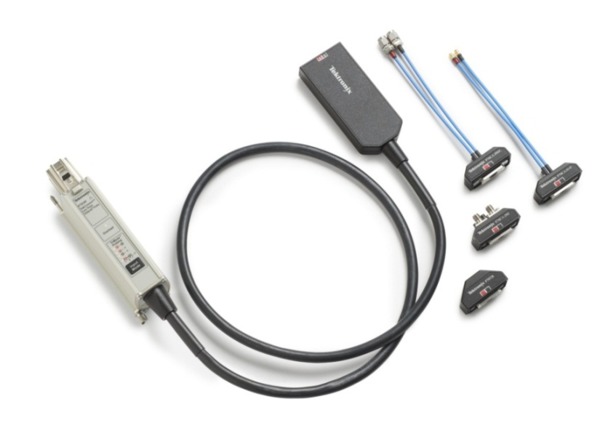
For more details on probe specifications, refer to the probe's datasheet:
Required equipment for MIPI® transmitter testing
For a complete list of required equipment, visit http://www.tek.com/MIPI.
Specifications
M-PHY TX characteristics
- Specification
- M-PHY Base Specification Revision 5.0 and Conformance Test Specification Version 1.0, Release 02.
- Probing configuration
- Both Differential and Single-ended Acquisition supported
- Reports
- .MHT format and PDF format, with pass/fail tables and waveform screenshots
- Data rates
- All HS, UFS4 Reference Clock, PWM, and SYS
- HS (High Speed) measurements
1.1.1 – HS-TX Unit Interval and Frequency Offset
1.1.2 – HS-TX Common-Mode AC Power Spectral Magnitude Limit
1.1.3 – HS-TX PREPARE Length
1.1.4 – HS-TX Common-Mode DC Output Voltage Amplitude
1.1.5 – HS-TX Differential DC Output Voltage Amplitude
1.1.6 – HS-TX G1 and G2 Differential AC Eye
1.1.7 – HS-TX G3, G4, and Differential AC Eye
1.1.8 – HS-TX 20/80% Rise and Fall Times
1.1.9 – HS-TX Lane-to-Lane Skew
1.1.10 – HS-TX Slew Rate Control Range
1.1.11 – HS-TX Slew Rate State Monotonicity
1.1.12 – HS-TX Slew Rate State Resolution
1.1.13 – HS-TX Intra-Lane Output Skew
1.1.14 – HS-TX Transmitter Pulse Width
1.1.15 – HS-TX Total Jitter
1.1.16 – HS-TX Short-Term Total Jitter
1.1.17 – HS-TX Deterministic Jitter
1.1.18 – HS-TX Short-Term Deterministic Jitter
BER Contour for extrapolated eye capability available for Test 1.1.6 and Test 1.1.7 with oscilloscope Option DJAN
- PWM (Pulse Width Modulation) measurements
1.2.1 – PWM-TX Transmit Bit Duration
1.2.2 – PWM-TX Transmit Ratio
1.2.3 – PWM-TX PREPARE Length
1.2.4 – PWM-TX Common Mode DC Output Voltage Amplitude
1.2.5 – PWM-TX Differential DC Output Voltage Amplitude
1.2.7 – PWM-TX Maximum Differential AC Output Voltage Amplitude
1.2.8 – PWM-TX 20/80% Rise and Fall Times
1.2.9 – PWM-TX Lane-to-Lane Skew
1.2.10 – PWM-TX G1 Transmit Bit Duration Tolerance
1.2.11 – PWM-TX G0 Minor Duration
- SYS (System clock) measurements
1.3.1 – SYS-TX Unit Interval and Frequency Offset
1.3.2 – SYS-TX Ref Clock Frequency
1.3.3 – SYS-TX PREPARE Length
1.3.4 – SYS-TX Common Mode DC Output Voltage Amplitude
1.3.5 – SYS-TX-Differential DC Output Voltage Amplitude test
1.3.7 – SYS-TX Maximum Differential AC Output Voltage Amplitude
1.3.8 – SYS-TX 20/80% Rise and Fall Times
1.3.9 – SYS-TX Lane-to-Lane Skew
- UFS4 Ref Clock measurements
- Frequency
- Frequency Error
- Input High Voltage
- Input Low Voltage
- Input Clock Rise Time
- Input Clock Fall Time
- Duty Cycle
- Random Jitter
- Deterministic Jitter
Ordering information
TekExpress M-PHY TX [MPHY50 and MPHY40]
| Model | Description |
|---|---|
| DPO//MSO70000/DX/SX | DPO (Digital Phosphor Oscilloscope), or MSO (Mixed Signal Oscilloscope) Oscilloscopes with Option DJA and Option DJAN (for BER Contours). Option DJA is mandatory. Option DJAN is optional but required for BER Contours. Option SDLA64 is mandatory for Gear4 and Gear5 Differential AC Eye measurements. The following bandwidths are needed:
|
DPO/MSO70000/DX/SX Option MPHY40 DPO-UP Option MPHY40 | TekExpress MIPI M-PHY Gear4 Tx Compliance Solution (Requires Opt. DJA and Opt. SDLA64) includes HS-Gear1, Gear2, Gear3, and Gear4; PWM, SYS, and UFS4 Reference Clock. |
| DPOFL-MPHY40 | TekExpress MIPI M-PHY Gear4 Tx Compliance Solution (Requires Opt. DJA and Opt. SDLA64) includes HS-Gear1, Gear2, Gear3, and Gear4; PWM, SYS, and UFS4 Reference Clock (Floating License version) |
DPO/MSO70000/DX/SX Option MPHY50 DPO-UP Option MPHY50 | TekExpress MIPI M-PHY Gear5 Tx Compliance Solution (Requires Opt. DJA and Opt. SDLA64) includes HS-Gear1, Gear2, Gear3, Gear 4, and Gear5; PWM, SYS, and UFS4 Reference Clock. |
| DPOFL-MPHY50 | TekExpress MIPI M-PHY Gear5 Tx Compliance Solution (Requires Opt. DJA and Opt. SDLA64) includes HS-Gear1, Gear2, Gear3, Gear4, and Gear5; PWM, SYS, and UFS4 Reference Clock (Floating License version) |
Recommended probes for TekExpress M-PHY TX
| Gear type | Maximum Data rate | Fixtured / RF connection |
|---|---|---|
| HS-Gear1 1 | 1.46 Gb/s | P76xx |
| HS-Gear2 | 2.92 Gb/s | P76xx |
| HS-Gear3 | 5.824 Gb/s | P76xx |
| HS-Gear4 | 11.648 Gb/s | P76xx |
| HS-Gear5 | 23.296 Gb/s | P76xx |
| PWM Gears (G0 to G7) 2 | 10 Kbps to 576 Mbps | P7313 |
| SYS Gears | 26 MHz 38.4 MHz 52 MHz | P7313 |

